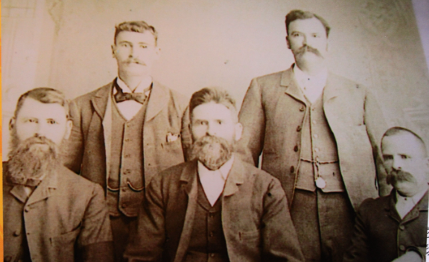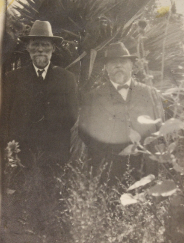Sharon Burnell and Ros Phillips have provided a photograph of some members of the Wood family, with some information as to who they might be. Sharon thinks the follow photo is of five brothers, either the sons of her great-great parents John and Rosannah Wood, or the sons of her great uncle Isaiah Wood and his wife Alveana Schmidt.
Mystery Photo – Sons of a brickmaker – but which brickmaker?

Some Facts (from Sharon)
Option 1: John Wood was a Staffordshire/Warwickshire brickmaker who arrived in Adelaide in 1853 on the Epaminondas with his wife and two infant sons (William and Isaiah). They lived for several years in the early Adelaide brick making areas of Kensington and Norwood, and had several more children (Mary Ann, Moses, Hannah, and Sarah Jane). By March 1862, when their son John Jr (Jack) was born, they were in Wallaroo, and by November 1865 when their daughter Selina was born, they were running a brickworks on the Moonta Mines. Their remaining children, Samuel, Rose, William Henry, Allan Isaac and Albert James, were all born on the Moonta Mines. The five sons who grew to adulthood were Isaiah (b1852), Jack (b 1862), Samuel (b 1868). Allan (b1873) and Albert (b 1877). Samuel died in Broken Hill in 1891, so if the photo is of them, it must have been taken before 1891. Although his brick kiln and drying sheds have all been dismantled, the cottage that John and Rosannah built on the Moonta Mines still exists.
Option 2: If the mystery photo is of Isaiah’s adult sons, then they are William (b1878), Albert James (yes, another one called Albert James, b1881), Allen Sidney (b1883), Henry Herbert (b1885), and the twins Stanley and Percy (b1892). They were born in Brompton, except for Henry who was born in Moonta. Like his father, Isaiah was a brickmaker, establishing his own brickworks in the area off Coglin St, Brompton. When the pug-holes and brickworks were closed down, the general area was used for dirt track car racing, and became known as the Rowley Park Speedway (see Rowley Park Speedway – Wikipedia).
Photo Analysis
On first glance the five sons look to be all about the same age, perhaps around thirty at a guess. (Michael had a guess that the clothing, especially the single-breasted vests and watch chains suggests a date of perhaps the 1860s. That would have them born in the 1830’s. But as we will see that is wrong. However, we did find this website for dating clothing, from the University of Vermont, which you might find useful:
https://glcp.uvm.edu/landscape_new/dating/clothing_and_hair/1860s_clothing_men.php
Sharon provided the following photo which is an interesting one historically speaking because it shows her great grandfather John Wood junior with John Verran.
Photo 2 – John (Jack) Wood and John Verran

John Verran was Premier of South Australia from 1910 to 1912. He was born in Cornwall in 1856 but he moved with his family to South Australia when he was only a baby. He began working in the Moonta copper mines before he was ten years old. He was a smart boy and the Primitive Methodists, who were strong throughout the copper mining areas of South Australia, took him under their wing and taught him to read. He was a trade unionist, elected to the presidency of the Amalgamated Miners Association in Moonta in 1895, and to the South Australian Parliament for the United Labour Party in 1901– the year of Australian Federation. However in later years he became stridently opposed to trade union militancy and to socialism in particular and eventually split from the Labor Party over the Conscription issue. That was an issue that deeply divided the whole of Australian society during World War One: Should Australian men be conscripted and forced to fight for Britain overseas? There were two referendums on the issue in 1916 and 1917, and in both cases the result was No. But the issue particularly split the Labor Party, because much of the Australian working class were of Irish Catholic background and in favour of Irish Independence and therefore opposed to Britain and the Empire, while significant sections of the Labor Party leadership were strongly pro-British and pro-Empire. John Verran was pro-Conscription. He was also a temperance campaigner.
The obvious question is: What is the relation between John Verran junior and John Wood? Was John Wood also a Primitive Methodist? Was he also a member of the Labor Party? Or was it just a professional and business relationship between the family who owned the brickworks at Moonta and the local MP? We know John Verran was born 1856, and we have Isaiah Wood who seems to be our man, Sharon’s great uncle, and he was born in 1852. Sharon tells us that John Wood Junior was the brother of Isaiah Wood, but quite a lot younger, and we saw from the birth entry for Isaiah Wood that indeed, John was 10 years younger, born in 1862. If the photo of the two of them was taken around 1927, that puts John Wood at age around sixty five.
Even as such mysteries remain unresolved, it is one of the great values of Family History as a discipline that we can start to place the threads of individual stories into the wider tapestry of unfolding history.
Our great thanks to Sharon Burnell for sharing this fascinating piece of family history